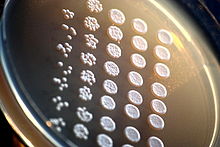
A viability assay is an assay that is created to determine the ability of organs, cells or tissues to maintain or recover a state of survival.[2] Viability can be distinguished from the all-or-nothing states of life and death by the use of a quantifiable index that ranges between the integers of 0 and 1 or, if more easily understood, the range of 0% and 100%.[3] Viability can be observed through the physical properties of cells, tissues, and organs. Some of these include mechanical activity, motility, such as with spermatozoa and granulocytes, the contraction of muscle tissue or cells, mitotic activity in cellular functions, and more.[3] Viability assays provide a more precise basis for measurement of an organism's level of vitality.
Viability assays can lead to more findings than the difference of living versus nonliving. These techniques can be used to assess the success of cell culture techniques, cryopreservation techniques, the toxicity of substances, or the effectiveness of substances in mitigating effects of toxic substances.[4]
- ^ Welch AZ, Koshland DE (2013). "A simple colony-formation assay in liquid medium, termed 'tadpoling', provides a sensitive measure of Saccharomyces cerevisiae culture viability". Yeast. 30 (12): 501–509. doi:10.1002/yea.2989. ISSN 1097-0061. PMID 24185677. S2CID 21664332.
- ^ Gavanji S, Bakhtari A, Famurewa AC, Othman EM (January 2023). "Cytotoxic Activity of Herbal Medicines as Assessed in Vitro: A Review". Chemistry & Biodiversity. 20 (2): 3–27. doi:10.1002/cbdv.202201098. PMID 36595710. S2CID 255473013.
- ^ a b Pegg DE (1989-06-01). "Viability assays for preserved cells, tissues, and organs". Cryobiology. 26 (3): 212–231. doi:10.1016/0011-2240(89)90016-3. ISSN 0011-2240. PMID 2743785.
- ^ "Overview of Probes for Cell Viability, Cell Proliferation and Live-Cell Function—Section 15.1 - US". www.thermofisher.com. Retrieved 2020-03-04.